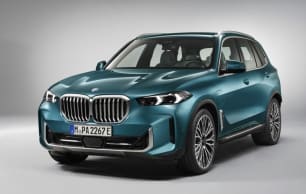The cabin offers enough space for a small SUV. It feels wide across the front seat and there’s plenty of headroom, too.
The driver’s seat is power adjustable and while the fabric and stitching look cool, there’s almost too much padding under your bottom.
There are clear controls on the comfy door armrest and on the lovely looking three-spoke synthetic leather, flat bottom steering wheel.
The console sits up high, presumably to give the cabin a sports car look, and the dash is neat and clean, largely due to a lack of physical buttons. There are two phone holders that dominate the lower part of the dash and they double as device chargers in higher grades, but not in the FX.
There is space under the console to fit a bag or other items but the USB-A and USB-C ports are on the passenger side so you have to reach over to connect a cord if required. Thankfully, the Apple CarPlay is wireless. It connected easily and did not require reconnection while I had the car.
Two smallish cupholders are found near the gear shifter, and a sizeable central bin will store a number or items. The doors can stow a tall and wide bottle as well as other flat items.
Chery’s dual-screen set-up looks nice and not a world away from Kia’s integrated screens. The driver instrument display is not customisable in this grade and many of the items on the display are quite small. It would help if these were a little larger.
The multimedia side is simple to use with iPhone-like icons for functions like vehicle settings and more. There’s even a cute little bubble face on the side that you press to dictate commands. I asked the system to perform a few basic tasks like turning the air con off and on and it did it immediately without fault.
Air con controls are housed in the screen as well but it’s not as fiddly as some systems from other manufacturers. The only complaint is that it doesn’t appear to show the exact temperature, and the air flow could be stronger for a hot climate like Australia.
Taller passengers will probably need to duck their heads getting in and out of the Omoda 5’s rear seats, because of the low roofline. Once in the rear, there is a decent amount of knee and legroom, and headroom is good too despite the roofline.
Those rear seats are flat and not the most comfortable but fine for urban drives, and they feature ISOFIX points on the two outboard seats and three top tether points for child car seats.
In terms of amenities, there’s one USB-C port in the second row, lower air vents - something too many small SUVs go without - a centre fold-down armrest with two (shallow) cupholders and enough space for big bottles in the doors.
All petrol Omoda 5s have a cargo capacity of 360 litres, which increases to 1075L when you fold the 60/40 split rear seats down. This is more than the GWM Haval Jolion petrol’s capacity (337L).
It has a manual tailgate, a high loading area and some under-floor storage, but there is more than enough space for some luggage or a large amount of groceries in the boot.
It has a temporary spare wheel which is essential in Australia if you’re driving beyond urban areas.
The only negative is the flimsy parcel shelf. It struggles to stay in the groves that are designed to hold it. I had to re-fit it every time I opened the boot.

